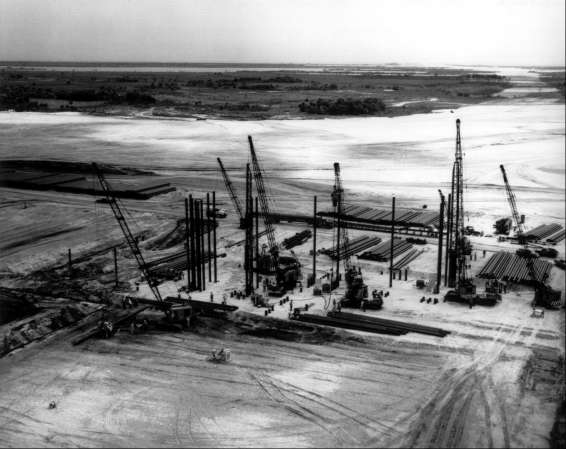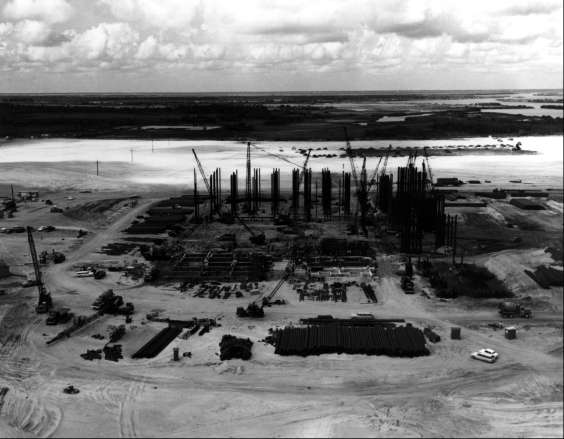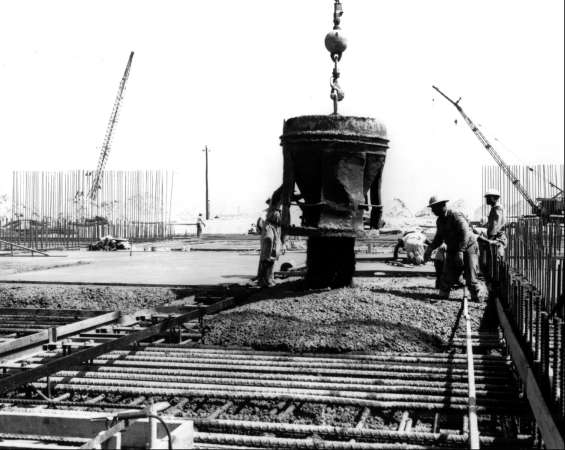
Laying the Foundations
Providing a firm foundation for construction on sandy soil had been one of the early design problems. Max O. Urbahn, head of one of the four firms in the design consortium, spoke of a second problem: "We were faced with the fascinating possibility that the shape of the building might make it react like an immense box kite; it could blow away in a high wind . . . ."10 The solution to both problems was to drive thousands of piles, steel pipes 41 centimeters in diameter, through the subsoil until they rested on bedrock. These served to anchor the building as well as to prevent the structure from sinking into the ground.11
The building stood only a few feet above sea level and near the ocean. Salt water, saturating the subsoil, reacted with steel piling to create an electrical current. To prevent this electrolytic process from gradually eating away the steel pipe, workmen grounded the piling by welding thick copper wire to each pile and connecting the wires to the steel reinforcing bars in the concrete floor slab. Until this was done, the VAB could lay claim to being the world's largest wet cell battery.12

Driving piles for the assembly building, August 1963.

Driving piles for the assembly building, September 1963.
Blount Brothers moved rapidly to assemble pile-driving equipment, steel piling, and workmen at the work site. They drove the first piles on 2 August 1963 and by 15 August had driven 9,144 meters of piling in the low bay area. The pipe for the piling came in 16.8-meter lengths, and welders had to join three and sometimes four lengths of pipe together to make up a single pile. To speed the work, Blount Brothers had their workmen weld at night and drive piles, which required better visibility, during the day. At the peak of activity, ten pile drivers were in action. Three of them were new, electrically driven, vibratory drivers that literally jigged the pilings into the ground. When the piles reached the first thin stratum of limestone at about 36 meters, steam- or diesel-driven pile drivers took over and pounded the piles into the bedrock, which ranged from 46 to 52 meters below the sandy surface. Although there were minor delays due to inclement weather - a week of unrelenting high winds and torrential rains brought all construction to a standstill in mid-September - the work on the foundations moved steadily ahead. The last of the piling was down on 3 January 1964, just five months after drivers pointed the first pile into the bedrock.13

Pouring the floor of the assembly building, July 1964.
As the pile drivers moved on, another group of Blount Brothers workmen moved in to erect the forms and place the reinforcing bars for the concrete pile caps and to bond the piles electrically to the reinforcing bars. To an observer in a helicopter, the VAB foundation site began to resemble a huge honeycomb with the concrete pile caps rapidly dividing the area into series of cells or boxes.14 As soon as the concrete had set in a series of the pile caps, workmen removed the forms and replaced any fill removed in the course of work. Then they poured a layer of crushed aggregate into the boxes and poured the asphalt and concrete floor slab on top of the aggregate. All told, Blount Brothers poured 38,200 cubic meters of concrete for pile caps and floor slab before the foundation was completed in May 1964.
Even before sinking the first pile of the foundation and beginning the steel framework of the VAB, the Corps of Engineers had taken the initial step toward awarding a contract for three large bridge cranes in the VAB.15 A 175-ton crane with a hook height of about 50 meters would run the length of the building and would traverse both the low bay and high bay areas above the transfer aisle. Two other cranes, with a 250-ton capacity and hook height of approximately 140 meters, would be capable of movement from an assembly bay on the opposite side. Although bridge cranes of this capacity are not unusual in heavy industry, the invitation for bids spelled out unique requirements for precision, smoothness, and control of their vertical and horizontal movement. The cranes would cost about $2,000,000. Colby Cranes Manufacturing Company of Seattle won the contract and agreed to have the cranes ready for final test on 1 September 1965.16
| Next |